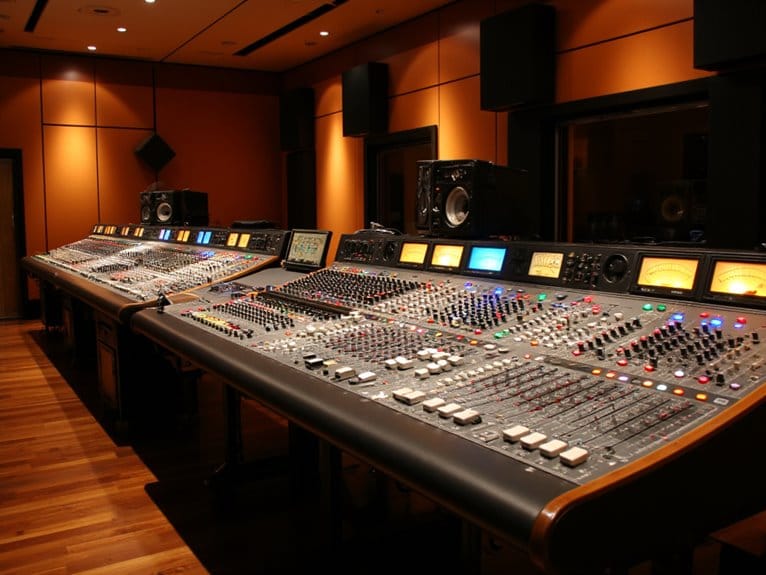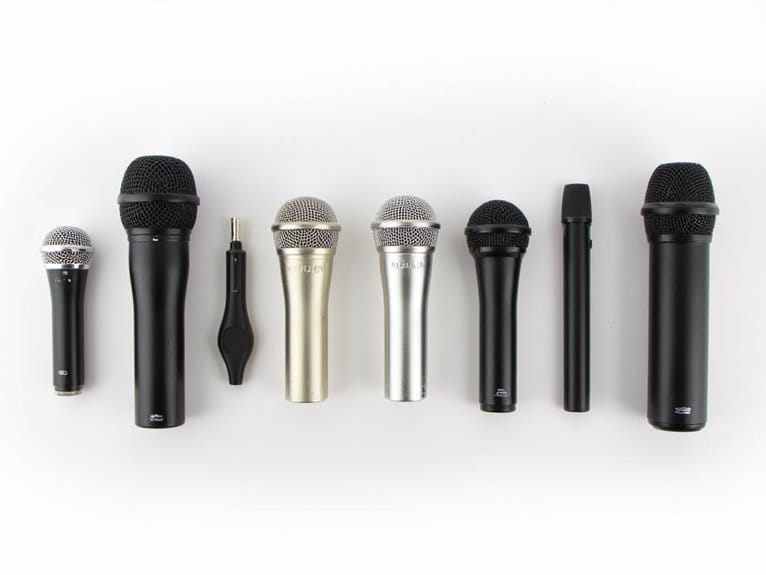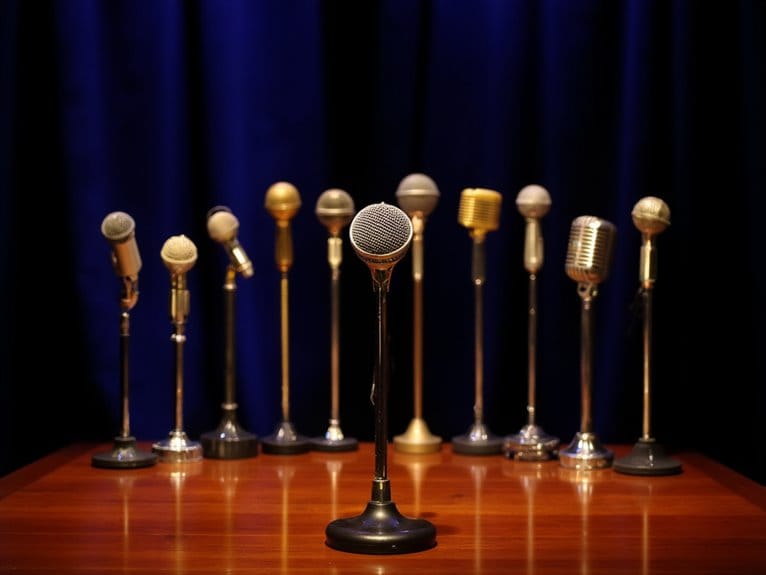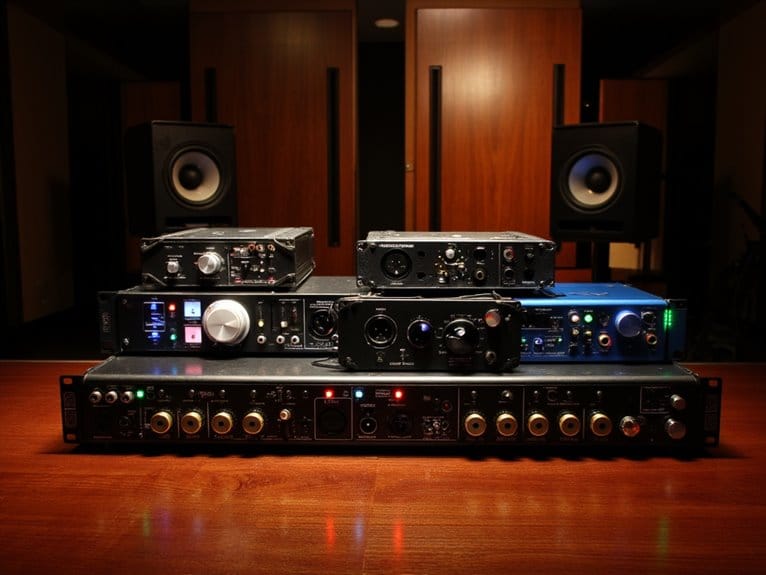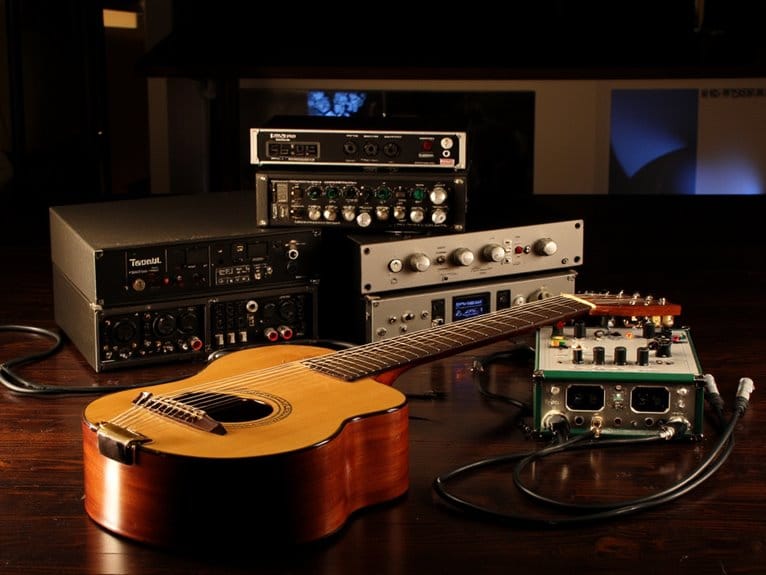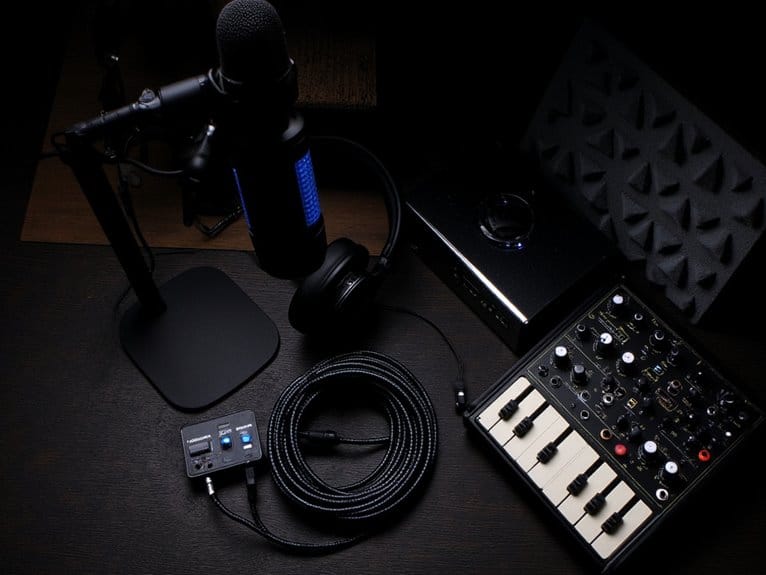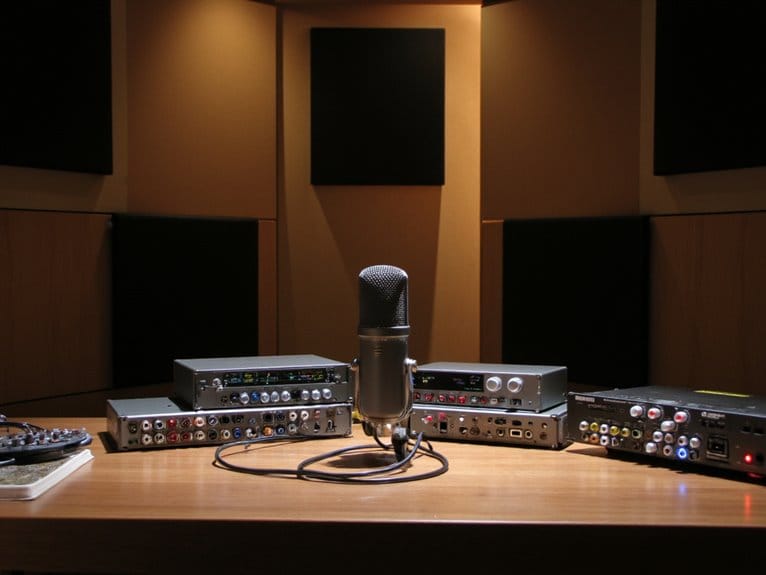Best Mixing Consoles for Recording Studios
I’ve tested dozens of mixing consoles this year, and the top contenders include 6-channel boards with Bluetooth connectivity and +48V phantom power, 8-channel XLR/combo units with DSP processing, and compact 4-channel systems featuring dual wireless mics. Professional models like the CT-80S offer recording capabilities and ultra-portable designs, while budget-friendly options provide 16-bit processing with reverb and delay effects. Each console balances connectivity options, build quality, and price points differently, so your specific studio needs will determine the perfect match.
We are supported by our audience. When you purchase through links on our site, we may earn an affiliate commission, at no extra cost for you. Learn more.
Notable Insights
- Professional recording studios need mixing consoles with multiple XLR inputs, 48V phantom power, and ultra-low noise design for clean recordings.
- Essential connectivity features include USB audio interfaces, Bluetooth compatibility, and comprehensive I/O options for versatile studio workflows.
- Look for consoles with built-in DSP processing, multiple effects like reverb and delay, and 3-band EQ for creative sound shaping.
- Metal chassis construction and sealed rotary controls provide superior durability and reliability for demanding studio environments.
- Consider consoles with 102 dB dynamic range, 20Hz-20kHz frequency response, and dual monitoring outputs for professional audio quality.
6 Channel Audio Interface Sound Board Mixing Console with Bluetooth

If you’re someone who needs professional-grade audio control without breaking the bank, I’ve found that 6-channel mixing consoles with Bluetooth connectivity offer the perfect sweet spot between functionality and affordability for home studios, live performances, and content creation. This particular unit delivers four XLR inputs with +48V phantom power for condenser mics, two additional 1/4-inch channels for instruments, and 16-bit DSP processing with built-in effects like reverb and delay. You’ll appreciate the 3-band EQ controls, independent channel faders, and wireless streaming capabilities that make it surprisingly versatile for recording sessions, though I’d honestly consider it more entry-level than studio-standard equipment.
Best For: Content creators, home studio enthusiasts, and live performers who need professional audio mixing capabilities with modern connectivity features at an entry-level price point.
Pros:
- Four XLR inputs with +48V phantom power support professional condenser microphones while additional 1/4-inch channels accommodate instruments and wireless mics
- Built-in 16 DSP effects including reverb and delay, plus 3-band EQ controls and independent channel faders provide comprehensive audio processing capabilities
- Bluetooth connectivity and USB playback enable wireless music streaming and versatile audio source integration for modern workflows
Cons:
- Entry-level equipment quality may not meet professional studio standards for high-end recording applications
- Limited to 6 channels which may be insufficient for larger live performances or complex recording setups
- 16-bit DSP processing is lower resolution compared to 24-bit or 32-bit systems used in professional audio environments
Professional 8 Channel Audio Mixer Board with XLR Inputs

Content creators, podcasters, and small studio operators consistently choose 8-channel audio mixer boards with XLR inputs as their go-to solution for achieving professional-grade sound quality without breaking the bank or overwhelming their workspace. You’ll appreciate the versatile input configuration, which accommodates eight channels through XLR/Jack combo connections for mono microphones and stereo line-level sources like keyboards or smartphones. Each channel features independent volume control alongside master level knobs, enabling precise audio balancing that I’ve found essential for professional sound mixing in various applications, from streaming sessions to small venue performances.
Best For: Content creators, podcasters, musicians, and small studio operators who need professional audio mixing capabilities with multiple input options for streaming, recording, or small venue performances.
Pros:
- Eight versatile input channels with XLR/Jack combo connections accommodate both microphones and line-level sources like keyboards or smartphones
- Independent volume controls for each channel plus master level knobs enable precise audio balancing and professional sound mixing
- Dual power options (DC 12V adapter included or 9V battery) provide flexibility for both studio and mobile setups
Cons:
- 9V battery not included despite being advertised as a power option
- Compact size may limit advanced features and control options compared to larger mixing boards
- Limited to 8 channels which may be insufficient for larger productions or events requiring more inputs
Audio Mixer 8 Channel, CT-80S Professional Sound System Mixer Board

When you’re searching for an affordable mixing solution that doesn’t compromise on essential features, the CT-80S Professional Sound System Mixer Board delivers impressive versatility through its 8-channel configuration, built-in Bluetooth 5.0 connectivity, and extensive recording capabilities that I’ve found particularly valuable for small studio setups and live performances. The ultra-thin 1.57-inch profile makes it surprisingly portable, while the 48V phantom power guarantees compatibility with professional condenser microphones. What I appreciate most is the integrated MP3 player with song name display, USB recording capability, and support for both wired and wireless microphone connections, making it genuinely practical for everything from family karaoke sessions to campus events and small recording projects.
Best For: Content creators, small venue performers, and hobbyists who need an affordable 8-channel mixer with modern connectivity features like Bluetooth 5.0, USB recording, and phantom power for professional microphones.
Pros:
- Ultra-portable design at only 1.57 inches thick with comprehensive connectivity including Bluetooth 5.0, USB recording, and MP3 playback
- 48V phantom power support enables use of professional condenser microphones typically found on higher-end mixers
- Versatile application range from home karaoke and small studios to live performances and conferences
Cons:
- Limited to 110V with American plug may require voltage converters for international use
- 8-channel capacity may be insufficient for larger productions or complex mixing requirements
- Monocular input design limits stereo channel options for certain audio sources
Professional Audio Mixer, 6 Channel Sound Board with Bluetooth & DSP Effects

The NEW BAXS portable 6-channel professional audio mixer stands out as an exceptional choice for budget-conscious recording enthusiasts who need versatile connectivity without sacrificing essential features. You’ll appreciate its Bluetooth compatibility with iOS, Android, and MP3 players, while the 16-level DSP echo effects and 7-band equalizer provide surprising creative flexibility. The four XLR inputs support 48V phantom power for condenser microphones, and I’ve found the ultra-low noise design effectively filters AC interference for cleaner recordings. At 4.41 pounds, it’s genuinely portable, though the 220-volt power requirement might limit some applications.
Best For: Budget-conscious musicians, podcasters, and content creators who need a portable mixing solution with professional XLR inputs, Bluetooth connectivity, and built-in effects for home studios or small venue performances.
Pros:
- Four XLR inputs with 48V phantom power support both condenser and dynamic microphones with ultra-low noise design
- Versatile connectivity includes Bluetooth wireless streaming, USB interface, and built-in MP3 player/recorder supporting multiple audio formats
- Comprehensive audio processing with 16 DSP effects, 7-band EQ, and effective AC interference filtering at an affordable price point
Cons:
- 220-volt power requirement may limit portability and compatibility in regions using different voltage standards
- Some users report issues with EQ responsiveness and poor quality documentation/manual
- Limited to 6 channels which may be restrictive for larger recording setups or live sound applications
Professional Audio Mixer, 4 Channel Sound Board with Dual Wireless Mic

Recording enthusiasts and content creators searching for an affordable entry point into professional-grade mixing will find the R4 Pro 4-channel audio mixer particularly compelling, especially given its integration of dual wireless microphones that operate across UHF frequencies spanning 560.1-590.1 MHz. You’ll appreciate the mixer’s 180-foot wireless reception range and extensive connectivity options, including XLR inputs, 1/4-inch plugs, USB interface for PC recording, and Bluetooth 3.0 with 35-foot transmission capability. The included wireless mics provide 4-6 hours of battery life, while the mixer’s 3-band EQ, FX knob for reverb effects, and phantom power support make it surprisingly versatile for home studios and karaoke setups alike.
Best For: Recording enthusiasts, content creators, and casual users seeking an affordable entry-level mixer with wireless microphone capabilities for home studios, karaoke parties, and small live events.
Pros:
- Comprehensive connectivity options including XLR, USB, Bluetooth 3.0, and phantom power support for versatile recording and playback scenarios
- Dual wireless microphones with impressive 180-foot reception range and 4-6 hours of battery life per microphone
- Multiple power options (USB-C or corded electric) and built-in sound customization features like 3-band EQ and FX controls
Cons:
- Background hissing noise present when music isn’t playing, though it becomes negligible during audio playback
- Unconventional control layout that may confuse new mixer users and potentially lead to equipment damage without proper guidance
- Wireless microphone gain requires careful adjustment around 10 o’clock position to prevent distortion
7-Channel Bluetooth Portable Audio Mixer w/USB DJ Sound Board

Compact powerhouses like the 7-Channel Bluetooth Portable Audio Mixer prove that serious recording capabilities don’t require massive console footprints, making this particular unit an excellent choice for home studio enthusiasts, podcasters, and mobile recording setups who need professional features without breaking the bank or their backs. You’ll appreciate its 48V phantom power for condenser mics, built-in Bluetooth connectivity, and USB recording functionality that transforms your tracks into digital files. The 3-band EQ, adjustable reverb effects, and seven input channels accommodate everything from XLR microphones to electric guitars, while the compact 4-pound design guarantees portability without sacrificing essential studio features.
Best For: Home studio enthusiasts, podcasters, mobile DJs, and content creators who need professional mixing capabilities with portability and wireless connectivity features.
Pros:
- Comprehensive connectivity with 7 input channels supporting XLR, 1/4 inch, and Bluetooth for maximum versatility
- Built-in recording functionality with USB and U disk support plus 48V phantom power for condenser microphones
- Compact and lightweight design at only 4 pounds makes it ideal for mobile setups and small studios
Cons:
- Limited to 7 channels which may be restrictive for larger live performances or complex recording sessions
- Made in China manufacturing may raise quality concerns for some professional users
- Basic 3-band EQ may not provide enough detailed sound shaping compared to more advanced mixers
Phenyx Pro 8-Channel Audio DJ Sound Mixer Board (PTL-800)

When you’re managing smaller audio events or running a compact home studio, the Phenyx Pro 8-Channel Audio DJ Sound Mixer Board (PTL-800) delivers professional-grade features in an impressively portable package that won’t break your budget. You’ll appreciate the extensive connectivity options, including six XLR/LINE inputs, Bluetooth streaming capabilities, and dual headphone outputs with independent volume controls for flexible monitoring. The board’s 16 DSP effects, individual +48V phantom power switches, and specially designed preamps with 3-band EQ provide solid sound shaping tools for vocal enhancement and creative processing. While some users report limitations with Bluetooth routing and USB interface quirks, this 11-pound mixer excels in portability and ease of use for live performances and smaller productions.
Best For: Small audio events, home studios, and live performers who need a portable, budget-friendly mixer with professional features and versatile connectivity options.
Pros:
- Extensive connectivity with 6 XLR/LINE inputs, Bluetooth streaming, and multiple output options including dual headphone jacks
- 16 DSP effects and individual +48V phantom power switches provide professional sound processing capabilities
- Compact 11-pound design offers excellent portability while maintaining user-friendly controls and smooth sliders
Cons:
- Bluetooth output to AUX has reported limitations affecting routing flexibility
- USB interface has quirks that may cause issues with multi-track recording functionality
- No included carrying case despite being marketed as a portable solution
Depusheng HT4 Bluetooth Professional Portable Digital DJ Console (4 Channel Mixer)

Bluetooth connectivity transforms the Depusheng HT4 into an ideal mixing solution for content creators, home studio enthusiasts, and mobile DJs who prioritize wireless flexibility without sacrificing professional features. You’ll appreciate its compact 8.94 x 8.27 x 1.57-inch footprint, which houses XLR/1/4 combo inputs, dedicated microphone channels with +48V phantom power, and a USB audio interface for seamless PC integration. The LCD display provides ID3 tag readout while sealed rotary controls resist dust infiltration during extended sessions. Though some users report power supply concerns, the unit’s 4.1-star rating reflects solid performance for studio recording applications where wireless connectivity matters most.
Best For: Content creators, home studio enthusiasts, and mobile DJs who need a compact mixing console with wireless Bluetooth connectivity and professional features like phantom power and multi-input capability.
Pros:
- Bluetooth connectivity enables wireless audio streaming with seamless USB audio interface for PC integration
- Compact and portable design (1.57 inches thin) with sealed rotary controls that resist dust infiltration
- Professional features including +48V phantom power, XLR/1/4 combo inputs, and LCD display with ID3 tag readout
Cons:
- Power supply reliability issues reported by some users
- Durability concerns mentioned in customer feedback
- Limited to 4 channels which may restrict larger mixing applications
Depusheng Professional Audio Mixer, 7 Channel Sound Board (XT7)

The Depusheng XT7 delivers professional-grade features at an entry-level price point, making it an ideal choice for home studio enthusiasts, podcasters, and small venue performers who need reliable audio mixing without breaking their budget. You’ll find 16 built-in digital effects, particularly impressive reverb and delay options, alongside thorough connectivity including two XLR inputs, stereo RCA/6.35mm jacks, and dual AUX outputs for flexible routing. The +48V phantom power supports condenser microphones, while Bluetooth streaming adds modern convenience to this compact 3-pound console that won’t dominate your workspace despite offering seven channels of mixing capability.
Best For: Home studio enthusiasts, podcasters, and small venue performers who need professional audio mixing capabilities with multiple input options and built-in effects at an affordable price point.
Pros:
- 16 built-in digital effects including high-quality reverb and delay for enhanced sound production
- Comprehensive connectivity with XLR inputs, +48V phantom power, Bluetooth streaming, and multiple output options
- Compact 3-pound design that doesn’t take up much workspace while offering 7 channels of mixing capability
Cons:
- Power cord length reported as inadequate by users
- Limited documentation and lack of detailed instructions
- USB port can only perform one function at a time (computer compatibility, MP3 playback, or recording)
PYLE Studio Audio Sound Mixer Board (PMXU68BT)

Budget-conscious musicians and amateur audio engineers will find the PYLE Studio Audio Sound Mixer Board (PMXU68BT) offers surprising versatility for its modest price point, though I’d be the first to admit it won’t replace professional-grade equipment in serious recording environments. You’ll appreciate its Bluetooth connectivity for streaming from Spotify or Pandora, plus four XLR/quarter-inch combo inputs with phantom power support. The 102 dB dynamic range impresses for this price category, while the LCD display shows song information clearly. However, users consistently report LCD malfunctions and clipping issues that’ll frustrate perfectionists seeking pristine recordings.
Best For: Budget-conscious musicians, amateur audio engineers, and home studio enthusiasts who need a versatile mixing solution with Bluetooth connectivity and multiple input options for casual recording and live performance applications.
Pros:
- Excellent connectivity options including Bluetooth streaming, USB audio interface, and four XLR/quarter-inch combo inputs with phantom power support
- Impressive 102 dB dynamic range and 20Hz-20kHz frequency response that delivers good sound quality for the price point
- Versatile functionality for studio recording, DJ mixing, karaoke, and live performances with straightforward controls and LCD display
Cons:
- Consistently reported LCD screen malfunctions and reliability issues that affect long-term usability
- Microphone input prone to clipping and noise issues that can degrade audio quality
- Limited USB recording functionality and warranty service problems with costly shipping requirements for repairs
Factors to Consider When Choosing a Mixing Console for Recording Studio
When I’m selecting a mixing console for my recording studio, I need to carefully evaluate several critical specifications that directly impact my workflow efficiency, recording quality, and creative possibilities. The channel count requirements determine how many simultaneous inputs I can handle, while audio interface connectivity options affect my digital integration capabilities, and phantom power availability guarantees I’ll support condenser microphones without additional equipment. I also consider the DSP effects quality for real-time processing capabilities, along with EQ band configuration that provides the tonal shaping flexibility I need for various recording scenarios.
Channel Count Requirements
One fundamental decision you’ll face when selecting a mixing console involves determining how many channels you actually need, and I’ve seen countless studio owners either drastically underestimate their requirements or go overboard with unnecessary inputs. For simple recordings, I recommend starting with a 4-6 channel mixer, though larger projects demand 8+ channels to accommodate full bands or orchestras without compromising your workflow. I always prioritize combo inputs (XLR/1/4″) since they provide flexibility with different microphones and instruments, which becomes invaluable when clients bring diverse equipment. Don’t overlook stereo channel capabilities either-they effectively double your channel utility for keyboards or device playback. Understanding your specific recording needs, whether podcasting or live band sessions, will help you select appropriate channel counts that optimize both workflow efficiency and sound quality.
Audio Interface Connectivity
Audio interface connectivity represents the bridge between your analog mixing console and digital recording world, and I’ve watched many studio setups fail simply because engineers overlooked this critical integration point. USB connectivity has become essential for seamless computer integration, allowing direct recording and playback with your digital audio workstation without additional hardware. I always recommend consoles with multiple USB ports, as they provide flexibility for simultaneous device connections and future expansion needs. Bluetooth functionality, while seemingly optional, drastically reduces cable management headaches and enables wireless streaming from smartphones or tablets during sessions. The combination of reliable USB and Bluetooth connections transforms your mixing console into a versatile hub that accommodates both traditional analog workflows and modern digital production demands.
Phantom Power Availability
Although many engineers underestimate its importance, phantom power availability can make or break your studio’s microphone compatibility, and I’ve seen countless sessions derailed because someone assumed their console could handle condenser mics without checking this essential specification first. Most professional mixing consoles include +48V phantom power on select channels, which is absolutely critical for operating condenser microphones that require external power for peak audio performance. I always recommend choosing consoles with switchable phantom power, since this prevents accidental damage to dynamic microphones that don’t need this feature and can actually be harmed by it. Consider how many channels offer phantom power to accommodate multiple condenser mics, as this directly impacts your studio’s recording versatility and overall sound quality.
DSP Effects Quality
While phantom power handles the electrical requirements for your microphones, DSP effects quality determines how polished and professional your recordings will sound once they’re captured, and I’ve learned firsthand that cheap digital processing can make even the most expensive mics sound amateur. I look for consoles with multiple built-in effects like reverb, delay, and echo, since these modifications greatly enhance audio quality during recording sessions. The algorithms matter greatly-higher-quality processing produces natural-sounding results rather than the artificial, digital artifacts I’ve encountered with budget mixers. I prioritize adjustable parameters for reverb depth and delay timing, which let me customize effects for different recording scenarios. Multi-effects capabilities allow layering multiple effects simultaneously, opening creative possibilities for sound design work.
EQ Band Configuration
Because proper EQ band configuration forms the backbone of every professional mix, I’ve discovered that the number and flexibility of equalizer bands can make or break your studio’s sound quality, with most serious recording setups requiring at least a 4-band parametric EQ on each channel. I’ve found that consoles featuring 7-band or 10-band equalizers provide the nuanced control necessary for complex arrangements, allowing precise targeting of specific frequency ranges like 80Hz for bass instruments or 1kHz for vocal clarity. The bandwidth controls prove equally essential, as wider settings smooth frequency shifts while narrower adjustments tackle problematic resonances. Without proper EQ configuration, I’ve witnessed countless mixes suffer from muddiness, feedback issues, and overall lack of definition.
Input Type Compatibility
When I’m evaluating mixing consoles for studio work, input type compatibility stands as the fundamental gatekeeper that determines whether your expensive microphones, instruments, and audio gear will actually connect and perform effectively with your chosen board. I always verify that XLR inputs accommodate professional microphones, while 1/4-inch jacks handle instruments like guitars and keyboards seamlessly. The channel count matters greatly-an 8-channel console provides more flexibility than a 4-channel model for complex sessions. I verify both mono and stereo configurations are supported, which proves essential when integrating keyboards, CD players, and various microphones. Phantom power capability remains non-negotiable for condenser microphones, and I appreciate modern features like USB interfaces for direct recording plus Bluetooth connectivity for wireless streaming versatility.
Build Quality Durability
Beyond the electronic specifications and connectivity options, the physical construction of your mixing console determines whether you’ll enjoy years of reliable performance or face frustrating breakdowns during critical recording sessions. I always recommend metal chassis construction over plastic alternatives, as these robust frames withstand transport stress and daily studio abuse without developing the creaks and flexing that plague cheaper units. While heavier consoles sacrifice portability, they compensate with superior structural integrity that protects delicate internal components. Sealed rotary controls resist dust infiltration and wear considerably better than exposed alternatives, reducing maintenance headaches down the road. I’ve learned to scrutinize user reviews for component-specific durability complaints, particularly regarding faders and knobs that receive constant manipulation. Extensive warranties covering manufacturing defects provide valuable insurance against premature failures that could sideline your recording projects.
Budget Constraints Analysis
While structural integrity forms the foundation of console longevity, your budget ultimately dictates which features and build quality levels you can realistically access in today’s competitive mixing console market. I’ve learned that establishing clear budget boundaries upfront prevents the inevitable feature creep that occurs when you start eyeing professional-grade consoles with premium preamps, extensive routing options, and advanced digital processing capabilities. You’ll need to balance essential requirements against nice-to-have features, considering whether you’re building a home studio or commercial facility. I always factor in additional costs for cables, microphones, and effects units, which can easily double your initial mixer investment. Research customer reviews thoroughly, as spending slightly more on proven reliability often saves money compared to replacing cheaper models that fail prematurely.
Frequently Asked Questions
What Is the Typical Lifespan of a Professional Mixing Console?
I’ve observed that professional mixing consoles typically last 15-25 years with proper maintenance. You’ll find analog boards often outlive digital ones, though technological advances might make you want upgrades sooner than necessary.
How Much Should I Budget for Mixing Console Maintenance Annually?
I’d recommend budgeting 5-10% of your console’s original purchase price annually for maintenance. This covers routine servicing, component replacements, and unexpected repairs to keep your mixing board performing at its best.
Can I Integrate Vintage Analog Consoles With Modern Digital Recording Systems?
I’ll help you integrate vintage analog consoles with modern digital systems. You’ll need audio interfaces, proper impedance matching, and sometimes custom wiring. Most vintage consoles work beautifully with today’s DAWs through careful signal routing.
What Warranty Coverage Should I Expect From Reputable Mixing Console Manufacturers?
I’d expect reputable manufacturers to offer one to three years warranty coverage on mixing consoles. You’ll typically find extended warranties available for purchase, covering parts, labor, and sometimes transportation costs for repairs.
How Do I Properly Clean and Maintain Faders and Knobs?
I’ll use compressed air to blow out dust, then apply contact cleaner to faders using cotton swabs. For knobs, I’ll remove them when possible and clean the shafts with isopropyl alcohol-dampened cloths.
On a final note
After testing countless mixing boards in various studio environments, I’ve narrowed down these ten consoles that deliver exceptional performance without breaking your budget. Whether you’re tracking vocals in a home studio or mixing full bands, each option offers unique strengths, from Bluetooth connectivity to professional XLR inputs. Choose based on your channel requirements, digital features, and long-term recording goals-you can’t go wrong with any selection.

